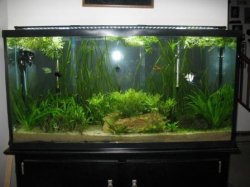Need a little help in picking out a fertilizer.
Prefer something that won't impact on my pet Betta.
Water parameters are 0 Ammonia and Nitrites. Nitrates = 40ppm. PH is 6.6 with KH at 1 and GH at 3.
Plants are doing Ok but I feel they could use a little help, especially the Cabomba.
Fish appears to be happy and sassy.
Want to keep him that way.

This is a low tech tank with good CFL lighting.
I've never messed with ferts before, so any help in selecting a good one would be great.
Thanks.
March...
Prefer something that won't impact on my pet Betta.
Water parameters are 0 Ammonia and Nitrites. Nitrates = 40ppm. PH is 6.6 with KH at 1 and GH at 3.
Plants are doing Ok but I feel they could use a little help, especially the Cabomba.
Fish appears to be happy and sassy.
Want to keep him that way.
This is a low tech tank with good CFL lighting.
I've never messed with ferts before, so any help in selecting a good one would be great.
Thanks.
March...


